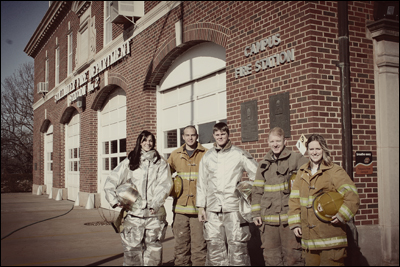Fire-Safety Program gets Presidential recognition
Thursday, February 5, 2009

School of Fire Protection and Safety Engineering Technology students, from left, Laura
Gross, Ben Eschner, Zac Thompson, Tom Mooney and Patrice Barnett stand outside the
campus fire station, this building is the original home to OSU's SFPS program. The
program, which began in 1937, is the largest and oldest fire-related academic program
in North America.
(February 5, 2009 Stillwater, OK) -Some of our nation’s most cherished documents, artifacts, and landmarks are being protected by graduates of Oklahoma State University’s School of Fire Protection and Safety Engineering Technology (SFPS).
OSU’s program, which is the only fire and safety program in the U.S. accredited through ABET, (formerly the Accreditation Board of Engineering and Technology), recently received national recognition when it was singled out by the President’s Committee on the Arts and Humanities (PCAH).
“As the only accredited program in Fire Protection and Safety in the U.S., and the largest and oldest fire-related academic program in North America, SFPS is a national treasure, and we need it to grow,” wrote Adair Margo, chairman of the President’s Committee on the Arts and Humanities, in a letter to OSU President Burns Hargis.
The President’s Committee on the Arts and Humanities recognizes that the nation’s cultural life contributes to the vibrancy of society and the strength of democracy, according to the PCAH web site. The PCAH carries out programs and initiatives of critical importance to the nation by focusing on four areas: international cultural cooperation, the needs of youth, the nation’s creative genius and preserving the nation’s cultural and historical treasures.
Save America’s Treasures is a PCAH program advocating the preservation of the nation’s most historically significant treasures. Dr. Michael Larrañaga, associate professor and department head of the SFPS, said OSU’s program is significant to the PCAH because of the nationwide emphasis on protecting art and cultural treasures from loss, which is what we teach here at OSU-loss prevention. Additionally, there is a tremendous shortage of qualified professionals in this field.
The SFPS prepares graduates to assess and reduce potential losses with respect to fire, safety, industrial hygiene and hazardous materials incidents in all sectors ranging from healthcare and petroleum industries to art and culture. Larrañaga said graduates are working to protect art, culture, and historical buildings throughout the world.
“Through their employers and jobs, our graduates protect structures of all types and their contents, including the Library of Congress, the Statue of Liberty, the Smithsonian Institution and U.S. Supreme Court Building,” Larrañaga said.
The FPST program is unique not only because it is the only accredited program in the nation, but also because it is an engineering technology degree, which offers hands-on experience and training in both fire protection and safety. Larrañaga said there are many programs in the U.S. that offer safety education, a few programs that offer fire protection education and even fewer programs that offer both.
Because OSU’s program is so well-known throughout the world, it means a lot in the fire protection and safety community to have a degree from OSU, according to Larrañaga.
“It definitely has significance to have a degree from our program,” Larrañaga said. “This is a very close-knit community, and our graduates are highly recruited. We also have many students come from out of state to attend OSU, just to participate in our program.”
OSU’s FPST program was the first to offer academic courses for the fire service beginning in the 1930’s. It was here that the publication of the Redbook, a fire protection training manual which would eventually evolve into its own entity, began. The FPST is approaching its 75th anniversary in 2012.
